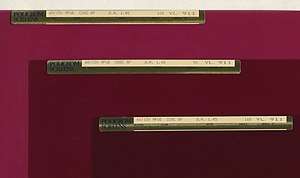Screen angle
In offset printing, the screen angle is the angle at which the halftones of a separated color is made output to a lithographic film, hence, printed on final product media.

Examples of typical CMYK halftone screen angles

Purple Screens. Angles 90°, 105°, 165°.
Motivation
In offset printing, colors are output on separate lithographic plates. Failing to use the correct set of angles to output every color may lead to a sort of optical noise called a moiré pattern which may appear as bands or waves in the final print. There is another disadvantage associated with incorrect sets of angle values, as the colors will look dimmer due to overlapping.
Typical values
While the angles depend on how many colors are used and the preference of the press operator, typical CMYK process printing uses any of the following screen angles:[1][2]
| C | 15° | 15° | 105° | 165° |
|---|---|---|---|---|
| M | 75° | 45° | 75° | 45° |
| Y | 0° | 0° | 90° | 90° |
| K | 45° | 75° | 15° | 105° |
gollark: No, they just aren't real.
gollark: `'NoneType' object has no attribute 'history'`. I imagine this is because some of the channels bridged here do not actually exist.
gollark: No, it crashed immediately.
gollark: Hmm. This doesn't actually work.
gollark: ++tel searchrecent <#830829987916414986> bees
References
- Campbell, Alastair. The Designer's Lexicon. 2000 Chronicle, San Francisco. p 192
- McCue, Claudia. Real World Print Production. 2007 Peachpit, Berkeley. p 31.
This article is issued from Wikipedia. The text is licensed under Creative Commons - Attribution - Sharealike. Additional terms may apply for the media files.